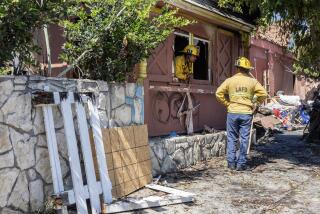ARCHITECTURE : Security Pacific Building Is First in Its Class
Security Pacific Plaza in Beverly Hills is an imposing structure that is easy to miss. Once you notice it, it towers over most of its neighbors and easily outclasses them in its design. But most of the time, it disappears behind a reserved mask of dark steel and bronze glass, leaving it to flashier buildings in downtown Beverly Hills to shout their colorful messages, then disappear as fashions change.
The Security Pacific building remains a beautifully composed colossus holding its own on Wilshire Boulevard. It is a reminder that less can turn out to be more.
The 11-story building was designed by the man who is perhaps Los Angeles’ greatest modernist, Craig Ellwood. Starting with a series of delicate little houses designed in the early 1950s, Ellwood perfected the notion of putting a building together as a grid of steel, filled in as much as possible with glass. He spent the next two decades boiling down all of the confusion and excitement of modern life to its most refined essence, and in the process created some of the most elegant boxes in town.
In the 1970s, this kind of highly machined, reserved architecture fell out of favor, and Ellwood retreated into making paintings. But recent years have seen a resurgence of interest in the sheer beauty of his buildings.
That beauty at first seems to be achieved by ignoring the site, the function of the building and any idea of scale in favor of a rigorous pursuit of structure and composition. In this case, the building is a slab divided into five bays in its length, and three bays in its depth. The result is a box with almost perfect proportions.
The structure is expressed in steel columns onto which I-beams have been welded for emphasis. The windows are made of a bronzed glass, and the space below them is filled in with dark metal plates. That is basically all there is to the building--everything else has been edited out.
There is, of course, an entrance, a narrow slot in the middle of the building, and the mechanical spaces housed on the top floor are expressed as dark louvers, which give the impression of a cornice. The only interior space open to the public is the two-story banking hall, a box of empty space overlooking Wilshire Boulevard.
But in front of this black box, Ellwood has placed a small pavilion, equally pure in its dimensions, defining the diagonal plaza formed by Bedford Drive and Wilshire Boulevard.
The little banking hall actually helps ease the transition from the smaller Beverly Hills streets to the larger scale of Wilshire Boulevard. In fact, the site of the Security Pacific Plaza turns out to be part of the reason why the building works so well.
For all of those self-sufficient qualities that would make you think this structure could be anywhere, it addresses its site with sensitivity and drama. Lined up perpendicularly to Wilshire, it puts one steel leg onto that grand street and shows its face to the approaching traffic, while using its pristine plaza to create a little breathing room for the crowded commercial neighborhood.
Only one discordant note reminds you that this is a commercial structure, not a civic monument: the name of the bank, pasted onto the top of the building in glaring white letters. Perhaps the recent merger with Bank of America will bring a more sensitive treatment to this landmark banking structure.
More to Read
The biggest entertainment stories
Get our big stories about Hollywood, film, television, music, arts, culture and more right in your inbox as soon as they publish.
You may occasionally receive promotional content from the Los Angeles Times.










